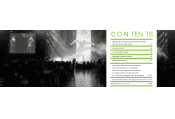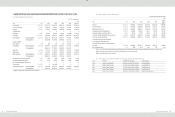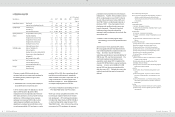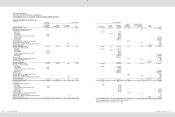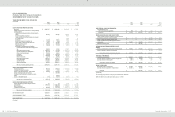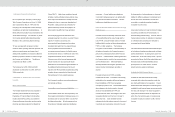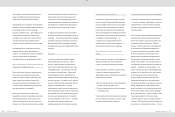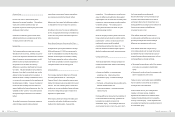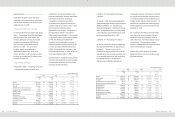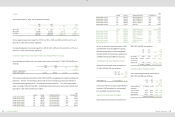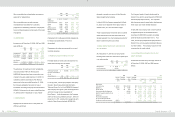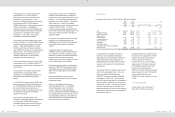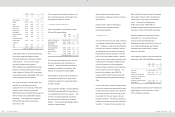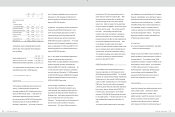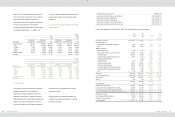HTC 2008 Annual Report Download - page 79
Download and view the complete annual report
Please find page 79 of the 2008 HTC annual report below. You can navigate through the pages in the report by either clicking on the pages listed below, or by using the keyword search tool below to find specific information within the annual report.
Financial Information
| 23
22 |
2008 Annual Report
investment discount arising on acquisitions before
January 1, 2006, the unamortized amount continues
to be amortized over the remaining year.
Profits from downstream transactions with an
equity-method investee are eliminated in proportion
to the Company’s percentage of ownership in the
investee; however, if the Company has control over
the investee, all the profits are eliminated. Profits
from upstream transactions with an equity-method
investee are eliminated in proportion to the
Company’s percentage of ownership in the investee.
When the Company subscribes for its investee’s
newly issued shares at a percentage different from
its percentage of ownership in the investee, the
Company records the change in its equity in the
investee’s net assets as an adjustment to
investments, with a corresponding amount credited
or charged to capital surplus. When the adjustment
should be debited to capital surplus, but the capital
surplus arising from long-term investments is
insufficient, the shortage is debited to retained
earnings.
Properties
Properties are stated at cost less accumulated
depreciation. Borrowing costs directly attributable
to the acquisition or construction of Properties are
capitalized as part of the cost of those assets.
Major additions and improvements to Properties are
capitalized, while costs of repairs and maintenance
are expensed currently.
Assets held under capital leases are initially
recognized as assets of the Company at the lower of
their fair value at the inception of the lease or the
present value of the minimum lease payments; the
corresponding liability is included in the balance
sheet as obligations under capital leases. The
interest included in lease payments is expensed
when paid.
Depreciation is calculated on a straight-line basis
over the estimated service lives of the assets plus
one additional year for salvage value:
buildings(including auxiliary equipment) - 3 to 50
years; machinery and equipment - 3 to 5 years;
office equipment - 3 to 5 years; transportation
equipment - 5 years; and leasehold improvements -
3 years.
Properties still in use beyond their original estimated
useful lives are further depreciated over their newly
estimated useful lives. Depreciation of revaluated
assets is provided on a straight-line basis over their
remaining estimated useful lives determined at the
time of revaluation.
The related cost (including revaluation increment),
accumulated depreciation, accumulated impairment
losses and any unrealized revaluation increment of
an item of properties are derecognized from the
balance sheet upon its disposal. Any gain or loss
on disposal of the asset is included in nonoperating
gains or losses in the year of disposal.
If the properties are leased to others, the related
costs and accumulated depreciation would be
transferred from properties to other assets - assets
leased to others.
Deferred Charges
Deferred charges are telephone installation charges,
computer software costs and deferred license fees.
Installation charges and computer software are
amortized on a straight-line basis over 3 years, and
deferred license fees, over 10 years.
Asset Impairment
If the recoverable amount of an asset is estimated to
be less than its carrying amount, the carrying
amount of the asset is reduced to its recoverable
amount. An impairment loss is charged to earnings
unless the asset is carried at a revalued amount, in
which case the impairment loss is treated as a
deduction to the unrealized revaluation increment.
If an impairment loss subsequently reverses, the
carrying amount of the asset is increased
accordingly, but the increased carrying amount may
not exceed the carrying amount that would have
been determined had no impairment loss been
recognized for the asset in prior years. A reversal
of an impairment loss is recognized in earnings,
unless the asset is carried at a revalued amount, in
which case the reversal of the impairment loss is
treated as an increase in the unrealized revaluation
increment. A reversal of an impairment loss on
goodwill is disallowed.
For long term equity investments for which the
Company has significant influence but with no
control, the carrying amount (including goodwill) of
each investment is compared with its own
recoverable amount for the purpose of impairment
testing.
Accrued Marketing Expenses
The Company accrues marketing expenses on the
basis of agreements, management’s judgment, and
any known factors that would significantly affect the
accruals. In addition, depending on the nature of
relevant events, the accrued marketing expenses
are accounted for as an increase in marketing
expenses or as a decrease in revenues.
Reserve for Warranty Expenses
The Company provides warranty service for one to
two years depending on the contract with customers.
The warranty liability is estimated on the basis of
management’s evaluation of the products under
warranty, past warranty experience, and pertinent
factors.
Product-Related Costs
The cost of revenues consists of costs of goods sold,
unallocated overheads, abnormal costs,
write-downs of inventories and the reversal of
write-downs. The provisions for product warranty
are estimated and recorded under cost of revenues
when sales are recognized.


